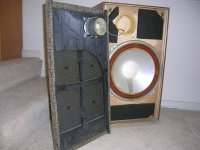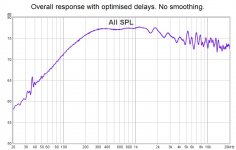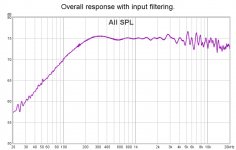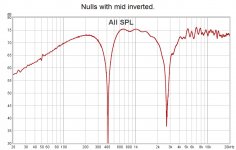It doesn't matter how you get the acoustical LR response. As i said earlier, the easiest method with DSP. You flatten the driver's acoustical response first, at least one octave above and below the xo point, but more is better. After flattening, you only need to apply the desired crossover slope, which means if you want LR4, then apply the LR4 filter for the desired frequency.
I always have liked a good loudspeaker, and listened to a few outstanding examples as a young man back around 1973.
This tune caught my ear, playing the lively drum and bass bottom section of Led Zeppelin's Black Dog.
Best speaker for that hideous but enjoyable racket was the Gale 401:
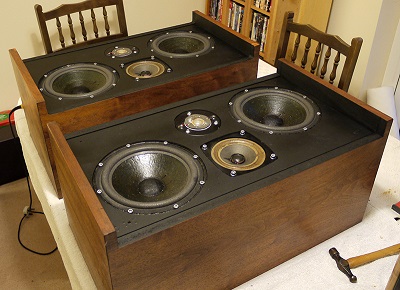
We call that great bottom end of a speaker "Slam" or "Projection". The Gale had it in spades.
Why? These days I think that closed box on a shallow second-order rolloff is much more foot-tapping than reflex with a steep fourth-order rolloff. Less group delay and better timing.
This is possibly not a great time to talk about how a steep filter introduces more phase shift and even more group delay than a shallow one.
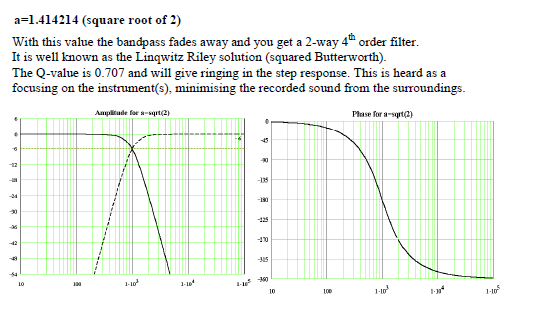
It's built into the laws of physics, that steep slopes equal steep phase shifts equals more group delay. A differential relationship for those who know function of a complex variable. Phase is the first derivative of frequency "w" versus time "t". Group delay is the second derivative.
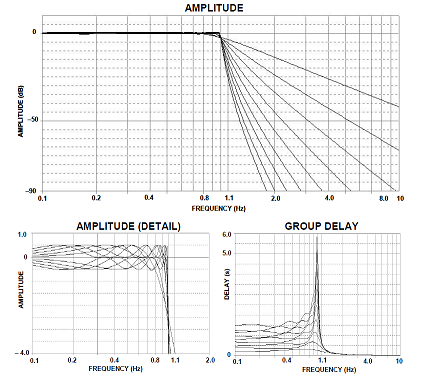
Actually, 200-y-o Cauchy mathematics. Let's not go into information theory. But ear-buds work well too.
This tune caught my ear, playing the lively drum and bass bottom section of Led Zeppelin's Black Dog.
Best speaker for that hideous but enjoyable racket was the Gale 401:
We call that great bottom end of a speaker "Slam" or "Projection". The Gale had it in spades.
Why? These days I think that closed box on a shallow second-order rolloff is much more foot-tapping than reflex with a steep fourth-order rolloff. Less group delay and better timing.
This is possibly not a great time to talk about how a steep filter introduces more phase shift and even more group delay than a shallow one.
It's built into the laws of physics, that steep slopes equal steep phase shifts equals more group delay. A differential relationship for those who know function of a complex variable. Phase is the first derivative of frequency "w" versus time "t". Group delay is the second derivative.
Actually, 200-y-o Cauchy mathematics. Let's not go into information theory. But ear-buds work well too.
Last edited:
It doesn't matter how you get the acoustical LR response. As i said earlier, the easiest method with DSP. You flatten the driver's acoustical response first, at least one octave above and below the xo point, but more is better. After flattening, you only need to apply the desired crossover slope, which means if you want LR4, then apply the LR4 filter for the desired frequency.
I took a shot at this today and found that it worked well. The only disadvantage to flattening each driver's response individually is that it uses lots of filters. I used a couple of input filters to flatten the overall response somewhat from around 200 Hz to 3 kHz, so there's not much left for room EQ. I might try dialing down the WM gains a little tomorrow instead. Here's where I'd got to by the end of the day:
Attachments
Nice graphs indeed. Of course nothing comes for free, everything has a price. There are other filter saving methods. You can combine the driver's natural roll-offs with the filter without flattening, similar like with passive crossovers.
For example: if you have a BW2 roll-off naturally, you need to apply a BW2 filter to the same frequency and you get a LR4 response for that frequency, because LR4 is comes from two cascaded BW2 response.
Or simply check where the frequency response is flat in a relative wide range and apply a LR4 (or whatever slope you want) to that region.
For example: if you have a BW2 roll-off naturally, you need to apply a BW2 filter to the same frequency and you get a LR4 response for that frequency, because LR4 is comes from two cascaded BW2 response.
Or simply check where the frequency response is flat in a relative wide range and apply a LR4 (or whatever slope you want) to that region.
Last edited:
But you don't want to time align the drivers because of crossover delay (1 period for LR4), you want to time align because the acoustical center of the drivers are ususally in different locations hence different distance to the listeing/measuring spot.
Phisically moving the higher frequency driver to compensate the delay caused by the crossover can work at one specific frequency but causes problems at other frequencies.
You're completely off topic, irrelevant at this point in the thread and at least here in the USA, horn system designers have been doing physical offset based on the XO point since circa 1934 until the advent of advanced electronics rendered it moot.
GM
It sounds like we're about the same vintage.
That's exactly what I have experienced - audible timing differences.
Yeah and why I don't like higher order XOs except down low where our hearing acuity is rolling off.
GM
You're completely off topic, irrelevant at this point in the thread and at least here in the USA, horn system designers have been doing physical offset based on the XO point since circa 1934 until the advent of advanced electronics rendered it moot.
GM
I am sorry, but you are the off-topic here with your horn stuff, please check the first post.
"let's say that we have a two-way speaker with zero acoustic alignment difference between the two drivers"
Ok, the starting question was hypothetical, but check the the opener's result in the last graphs, i think he is now more understand the situation.
Again, if you want to eliminate the low frequency driver delay (e.g. 1 period delay for LR4) caused by the crossing with physical movement, it does more harm than good to the sound at least in the phase domain.
We may not be thinking about the same thing (my english is not the best), but I know what I'm saying is right.
We may not be thinking about the same thing (my english is not the best), but I know what I'm saying is right.
Last edited:
Thank you for the illuminating discussion.
So how do I know that I have the right one? It now seems that this isn't the case, although I could still be off to a limited extent.
Rod Elliott alludes to the phenomenon of "slow bass", but doesn't elaborate much. I'm wondering whether that was what I heard from my ported box.
However, these produce only shallow nulls with the mid inverted, and tweaking them by a few hundredths of a millisecond either side makes the nulls even shallower.
You're welcome!
As I roundabout stated, with the one that yields the flattest phase and amplitude response.
Most likely the box, but can be its interaction with the room and/or improper delay with the HF, which with low tunings can need such a large delay [especially with horns] that folks assume they've made an error, so use what they think is 'right enough'.
As already noted, an XO only works right when there's sufficient flat BW on both sides of it otherwise it become some sort of acoustic XO and why with manually time/phase aligning a system it's necessary to move the HF around till the deep null is found, which in your case might be way off from the starting point.
GM
I took a shot at this today and found that it worked well. The only disadvantage to flattening each driver's response individually is that it uses lots of filters.
True, a common way with the common results and why some folks use passive for response shaping.
GM
I am sorry, but you are the off-topic here with your horn stuff, please check the first post.
"let's say that we have a two-way speaker with zero acoustic alignment difference between the two drivers"
Ok, the starting question was hypothetical, but check the the opener's result in the last graphs, i think he is now more understand the situation.
Not at all, just refuting your wrong 'sweeping' assertion.
Yes, really needed to have seen/responded to your response before all that's since been posted, but I take issue with being erroneously 'corrected'.
GM
I really don't get what you are saying. He is now created a good phase alignment and flat combined amplitude response with their drivers and DSP.Not at all, just refuting your wrong 'sweeping' assertion.
I am saying that a more than 1st order crossovered multiway speaker cannot be time-aligned with physically moving the drivers without messing the phase alignment. Physical movement is for phase alignment not time (the timing difference casued by higher order crossovers), ok phase is time but this time is frequency dependent, I don't think this is new for you.
If someone wants totally time aligned drivers with a more than 1st order crossovered speaker, then a FIR is the only choice yet. I don't know, horns can act like a FIR filter?
Last edited:
I think that those who the deity loves the most just say "I don't know" !
As far as I know, speakers are a 2 dimensional Clifford algebra. To be honest, hardly worth wasting our time on.
The really smart people have moved far beyond this. Into 8 dimensions. I am a great admirer of Cohl Furey.
If you want to see a Miracle, just look into the skies and watch the Orbital Resonance around Jupiter.

A 1:2:4 resonance. A bit like the driver ratios in the SEAS 3 way classic.
Can this be a coincidence. I don't think so.
As far as I know, speakers are a 2 dimensional Clifford algebra. To be honest, hardly worth wasting our time on.
The really smart people have moved far beyond this. Into 8 dimensions. I am a great admirer of Cohl Furey.
If you want to see a Miracle, just look into the skies and watch the Orbital Resonance around Jupiter.

A 1:2:4 resonance. A bit like the driver ratios in the SEAS 3 way classic.
Can this be a coincidence. I don't think so.
YSDR, there is still a lot to learn for you ;-)
There is no doubt that I have yet to learn. Who doesn't? I am not a mathematican.
My statements may be attackable and mathematically imperfect, but I think the starter of the topic understood what I had to say.
The opener understood a little better the basic existing crossover designs now I think, but sorry if I write wrong advices here.
Btw, can you eliminate the high order crossover delay without FIR fiters and maintain a good phase tracking between the drivers and not only at the crossover point?
Last edited:
Glad it helped, he generally explains things in a clear way.That was an excellent read. I almost understood a fair bit of it!
Ok then.a good phase alignment and flat combined amplitude response
I may not really understand it, so please explain to me what's wrong with that statement and with the OP's measurements. It's not have flat frequency amplitude (i see it as flat) or the driver's phases not matches to each other (the deep, wide reverse null shows to me that the drivers are phase aligned to the measuring spot with the intended polarity) ?Ok then.
Seriously interested.
- Status
- This old topic is closed. If you want to reopen this topic, contact a moderator using the "Report Post" button.
- Home
- Loudspeakers
- Multi-Way
- Phase and time delay
